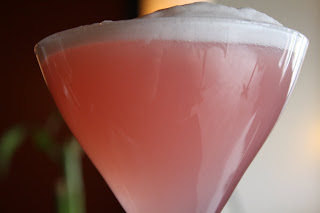As I'm sure that you know, Wednesday is St. Patrick's Day, or perhaps better known as
Anotherreasontogetreallydrunk Day. Despite being part Irish myself, I had sworn off going out drinking on Saint Paddy's years ago due to an overwhelming amount of amateurs drinking well beyond their capacity, trying as they might to be Irish for a day.
Instead, I prefer to honor the day the second-best way that I know how: cooking, and of course the only dish there is to discuss is
Corned Beef and Cabbage. Now, since I didn't want to take the straightforward approach (as usual) there were several variations that I could have taken. For instance, my best friend, Greg, celebrates the day by making
Reuben sandwiches, cooking them grilled cheese-style but with mayo instead of butter. Scoff if you must, but ignorance isn't bliss...
that sandwich is!! Nevertheless, I just didn't want this special to be a sandwich, so I decided to play off of the traditional dish more exclusively and make Reubens for me and my staff with the leftover trimmings!!! ;)
Over the last month or so I deliberated whether or not to cure my own brisket for this holiday (
fyi - the term corned refers to the corn kernel-sized salt used to brine the meat), but in the end I thought it was best to use pre-cured beef since it is during the cooking process that the magic happens.
In my opinion the best way to cook corned beef is in a large pan in the oven, submerged in liquid and spices, and being St. Patrick's Day there is only one liquid that comes to mind:
Guinness. Those of you regular followers might remember the inspiration for this when I braised beef in Guinness for a
risotto special earlier in the year. I kept the spices moderate and simple, just a little coriander, bay leaves and peppercorns to allow the beer to shine. While the beef cooked slowly in the oven I started on the other components.
For the sauce I wanted to toy with the traditional condiment of mustard without any chance of it overpowering the subtle flavors that I was developing while cooking the meat. To do so I created a sauce base of equal parts of white wine, chicken broth and heavy cream that I slowly reduced
with a medley of aromatics that included shallots, garlic, bay leaves, thyme and peppercorns. Once the mixture was the right consistency I strained and chilled it, awaiting the final dab of Dijon mustard upon order.
The cabbage for this dish deserves an interesting side note: as I stated above, I am part Irish, but the other part is German. While the two are remarkably different, culinarily speaking they share many similar keystones such as potatoes,
drinking and cabbage. As a graduation present from my mother, she and my stepfather took me on an European trip that included a stop in Munich, Germany where I sampled true versions of
sauerkraut that literally made any that I've had before taste like water. The
sauerkraut that I had at a restaurant across from the
Rathaus-Glockenspiel has remained in my memory still today, twelve years later. Even aside from its layers of pure craftsmanship there was one unique flavor that stood out: caraway. Growing up, like most Americans, I believed that rye bread tasted the way it does because of the caraway seeds and not the rye flour used to make it. Now, every time that I cook cabbage I try to impart some of that caraway flavor to pay tribute to the
sauerkraut that I had back in Munich as long as it doesn't take away from the dish as a whole.
So, to bridge my two heritages I integrated caraway into my braised cabbage for this dish by first simmering beef stock with aromatics similar to the mustard sauce above but with the addition of toasted caraway seeds for their floral aroma, which I used to cook the cabbage to order, imparting all of that wonderful flavor.
After all of that, I am left with the crucial final component: the potatoes. All along I wanted to encrust long portions of the cooked beef with potato, but after several attempts using different techniques I was still unsuccessful, but being a chef I was relentless with my vision and finally came up with a solution. By making very thin potato pancakes I was able to wrap the pieces of meat similar to using a crepe or tortilla. Once trimmed each serving was roasted in the oven to crisp the potato and heat the corned beef before being sliced and served over the cabbage and sauce.
 Happy Saint Patrick's Day!!!
Happy Saint Patrick's Day!!!
I still find it funny how one idea rolls into the next and into the next; it's that perpetual ball of creativity that gets me up in the morning, makes me want to work on my day off and, of course, fuels this blog.
 Once I got my hands on kumquats for my recent duck special they brought back a lot of great (yet still unfounded) ideas that I had for them back in my early days of cooking, but then again, I wasn't a self-proclaimed mixologist then either!!!
Once I got my hands on kumquats for my recent duck special they brought back a lot of great (yet still unfounded) ideas that I had for them back in my early days of cooking, but then again, I wasn't a self-proclaimed mixologist then either!!!
So I decided to enterprise on them while they are still in season by chopping and simmering the bittersweet fruit with a little bit of sugar into something that is somewhere between a juice and a syrup, but even after the addition of Absolut Mandarin and sans the sugar rim...... it surpasses anything that I've dreamt up before !!!
With Love,
Cheffrey










